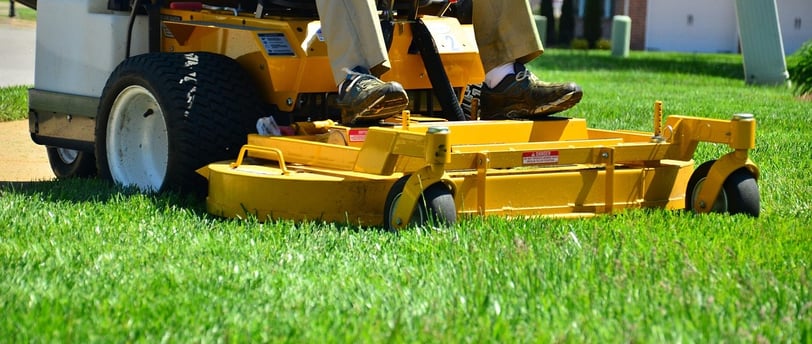Mowing 101: Lawn Mowing Tips for Iowa Homeowners
Proper mowing is the key to a great lawn. Discover expert lawn mowing tips from Heartland Grounds, such as height, frequency, and patterns for a healthy yard.
3/9/20253 min read


Mowing 101: Mastering the Art of Lawn Maintenance
Many homeowners dream of having a lush, weed-free lawn and may invest heavily in treatments and fertilizers. However, they often overlook the most fundamental aspect of lawn care: frequent and correct mowing. Proper mowing practices lay the foundation for a thriving lawn, preventing many common issues from arising in the first place.
At Heartland Grounds, we understand mowing isn't just about keeping grass short—it's a strategic task crucial to maintaining a healthy, vibrant lawn. Let's dive into the intricacies of proper mowing practices to help your lawn thrive throughout the season.
Height Matters: Finding the Sweet Spot
The height you mow your grass significantly impacts lawn health. In Iowa City and Coralville, cool-season grasses like Kentucky bluegrass, fescue, and ryegrass dominate lawns. These grasses flourish at heights between 3 and 4 inches. Taller grass shades the soil, conserves moisture, and naturally reduces weed growth by outcompeting invasive weeds for sunlight and nutrients.
Throughout spring, maintain your mower around 3 inches. During hot summer months, consider raising it slightly (around 3.5-4 inches). Taller grass provides shade to soil, reducing evaporation, and helping your turf maintain moisture during drought conditions.
Always follow the "one-third rule" by never removing more than one-third of your grass’s height at a time. Consistently following the one-third rule prevents stress, encourages healthy growth, and minimizes vulnerability to pests and disease. If you prefer a shorter lawn (though not necessarily advised), you must mow more frequently to adhere to this rule and avoid stressing your lawn.
Adjusting Mowing Frequency
Mowing frequency varies with seasons. Spring and early summer typically require at least weekly mowing to manage vigorous growth. Towards the end of the season, mowing every 10-14 days may be sufficient. Additionally, during periods of drought for those that can't water their lawn, it may make sense to mow less frequently. The traffic from your mower and walking through your yard can damage the dry, brittle grass blades. If you aren't watering during these conditions, your lawn will likely go dormant and not be growing super quickly anyways.
Sharpen Those Blades!
Dull blades tear grass instead of providing clean cuts, leading to brown, frayed tips, which increases susceptibility to pests and diseases. Sharpen mower blades at least twice a season or whenever you notice frayed grass tips for best results. Sharpening mower blades isn't too difficult, but it is another item of maintenance that can be a challenge for homeowners.
Mulch, Don't Bag
Instead of bagging clippings, allow them to mulch back onto the lawn. Mulched clippings break down quickly, returning valuable nitrogen and nutrients to your lawn, promoting natural fertilization, and reducing the need for chemical fertilizers.
Rotate Mowing Patterns
Change your mowing direction weekly to prevent soil compaction and grass leaning. Alternating directions helps grass grow upright and prevents ruts or uneven terrain from forming. This also promotes uniform growth, keeping your lawn looking pristine.
Mind the Edges
Clean edges along sidewalks, driveways, and garden beds elevate lawn aesthetics significantly. Many homeowners try to use their mower to cut the grass right next to their flower beds. This goes wrong when a tire goes over the edge, and they scalp their lawn (cut it down to the dirt). A better method is to use a string trimmer or edging tool after mowing to keep these boundaries crisp. Proper edging ensures your lawn has a neat, manicured appearance, enhancing curb appeal.
Weather and Timing Considerations
Avoid mowing during extreme heat, midday sun, or immediately after heavy rain. Mowing wet grass compacts soil and can leave uneven cuts, potentially damaging turf. The ideal time is mid-to-late morning or early evening, when temperatures are cooler, reducing stress on both the grass and operator.
Conclusion
Mowing is more than a routine chore; it's an essential component of lawn care. Implement these best practices from Heartland Grounds to create a lush, healthy lawn you'll be proud to showcase all season long. And of course, if you're ready to hand off the burden of your lawn care, Heartland Grounds would be happy to help you.
Heartland Grounds
Professional Care for Your Property
Proudly serving Coralville, North Liberty, Iowa City, Tiffin, & More
